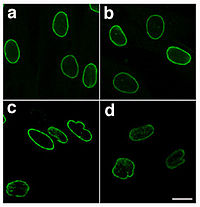
Hybrid capture of 964 nuclear genes resolves evolutionary relationships in the mimosoid legumes and reveals the polytomous origins of a large pantropical radiation
Sign Up to like & getrecommendations! Published in 2020 at "American Journal of Botany"
DOI: 10.1002/ajb2.1568
Abstract: PREMISE Targeted enrichment methods facilitate sequencing of hundreds of nuclear loci to enhance phylogenetic resolution and elucidate why some parts of the “tree of life” are difficult (if not impossible) to resolve. The mimosoid legumes… read more here.
Keywords: 964 nuclear; nuclear genes; resolution; mimosoid legumes ... See more keywords

Settling a family feud: a high-level phylogenomic framework for the Gentianales based on 353 nuclear genes and partial plastomes.
Sign Up to like & getrecommendations! Published in 2021 at "American journal of botany"
DOI: 10.1002/ajb2.1697
Abstract: PREMISE Comprising five families that vastly differ in species richness-ranging from Gelsemiaceae with 13 species to the Rubiaceae with 13,775 species-members of the Gentianales are often among the most species-rich and abundant plants in tropical… read more here.
Keywords: nuclear genes; framework; level; partial plastomes ... See more keywords

Targeted amplicon sequencing of 40 nuclear genes supports a single introduction and rapid radiation of Hawaiian Metrosideros (Myrtaceae)
Sign Up to like & getrecommendations! Published in 2019 at "Plant Systematics and Evolution"
DOI: 10.1007/s00606-019-01615-0
Abstract: Compared to traditionally used plastid or ribosomal markers, nuclear gene markers provide many advantages for molecular systematics of plants, and high-throughput sequencing technologies are making large nuclear datasets available at an unprecedented rate. We used… read more here.
Keywords: nuclear genes; hawaiian metrosideros; sequencing nuclear; targeted amplicon ... See more keywords

Differential expression of nuclear genes encoding mitochondrial proteins from urban and rural populations in Morocco
Sign Up to like & getrecommendations! Published in 2020 at "Cell Stress and Chaperones"
DOI: 10.1007/s12192-020-01108-x
Abstract: Urbanization in low-income countries represents an important inflection point in the epidemiology of disease, with rural populations experiencing high rates of chronic and recurrent infections and urban populations displaying a profile of noncommunicable diseases. To… read more here.
Keywords: mitochondrial proteins; nuclear genes; rural populations; genes encoding ... See more keywords

Phylogenetic relationships of rollers (Coraciidae) based on complete mitochondrial genomes and fifteen nuclear genes.
Sign Up to like & getrecommendations! Published in 2018 at "Molecular phylogenetics and evolution"
DOI: 10.1016/j.ympev.2018.03.030
Abstract: The rollers (Coraciidae) constitute a relative small avian family with ca. 12 species distributed in Africa, western and southern Eurasia, and eastern Australia. In this study we examine the phylogenetic relationships of all species currently… read more here.
Keywords: nuclear genes; complete mitochondrial; roller; mitochondrial genomes ... See more keywords

COMPREHENSIVE PHYLOGENETIC ANALYSES OF ORCHIDACEAE USING NUCLEAR GENES AND EVOLUTIONARY INSIGHTS INTO EPIPHYTISM.
Sign Up to like & getrecommendations! Published in 2023 at "Journal of integrative plant biology"
DOI: 10.1111/jipb.13462
Abstract: Orchidaceae (with >28,000 orchid species) are one of the two largest plant families, with economically and ecologically important species, and occupy global and diverse niches with primary distribution in rainforests. Among orchids, 70% grow on… read more here.
Keywords: phylogenetic analyses; comprehensive phylogenetic; epiphytism; orchidaceae using ... See more keywords

Conserved motifs in nuclear genes encoding predicted mitochondrial proteins in Trypanosoma cruzi
Sign Up to like & getrecommendations! Published in 2019 at "PLoS ONE"
DOI: 10.1371/journal.pone.0215160
Abstract: Trypanosoma cruzi, the protozoan parasite that causes Chagas’ disease, exhibits peculiar biological features. Among them, the presence of a unique mitochondrion is remarkable. Even though the mitochondrial DNA constitutes up to 25% of total cellular… read more here.
Keywords: mitochondrial proteins; nuclear genes; predicted mitochondrial; genes encoding ... See more keywords

Phylogenetic analysis of combined mitochondrial genome and 32 nuclear genes provides key insights into molecular systematics and historical biogeography of Asian warty newts of the genus Paramesotriton (Caudata: Salamandridae)
Sign Up to like & getrecommendations! Published in 2022 at "Zoological Research"
DOI: 10.24272/j.issn.2095-8137.2022.081
Abstract: The Paramesotriton Chang, 1935 genus of Asian warty newts is the second most diverse genus in the family Salamandridae, currently containing 14 recognized species from northern Vietnam to southwest-central and southern China. Although species of… read more here.
Keywords: warty newts; asian warty; paramesotriton; china ... See more keywords

Not All Molossus are Created Equal: Genetic Variation in the Mastiff Bat Reveals Diversity Masked by Conservative Morphology
Sign Up to like & getrecommendations! Published in 2019 at "Acta Chiropterologica"
DOI: 10.3161/15081109acc2019.21.1.004
Abstract: The genus Molossus of the free-tailed bat family Molossidae is morphologically conservative and the level of genetic divergence is also low among many species, which has masked the actual species diversity in the genus. We… read more here.
Keywords: equal genetic; created equal; molossus; nuclear genes ... See more keywords